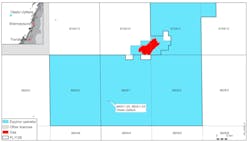Equinor makes commercial gas discovery offshore Norway
Equinor discovered gas in production license 1128 in the Norwegian Sea and will consider tieback to Irpa field. The commercial discovery, Obelix Upflank, holds estimated recoverable gas of 2-11 billion standard cu m, or about 12.6-69.2 MMboe, the operator said in a release Jan 18.
Exploration wells 6605/1-2 S&A were drilled by the Deepsea Stavanger drilling rig, about 23 km south of the Irpa gas discovery, and 350 km west of Sandnessjøen.
The objective of well 6605/1-2 S was to prove petroleum in Upper Cretaceous reservoir rocks in the Springar formation. The objective of appraisal well 6605/1-2 A was to confirm the discovery in a downfaulted neighboring segment, the Norwegian Petroleum Directorate said in a separate release.
Well 6605/1-2 S encountered three sandstone layers in the Springar formation, with moderate to good reservoir quality. The uppermost sandstone layer, about 10-m thick, was gas-bearing. In the 35-m middle sandstone layer, a 2-m gas column was encountered, and the gas-water contact was proven at about 3,190 m subsea. The lowest sandstone layer was 25 m thick and water-bearing.
Well 6605/1-2 A proved a 12-m gas column in the uppermost sandstone layer, with moderate to good reservoir quality. No gas-water contact was encountered. The deeper sandstone layers are water-bearing.
Pressure data indicates communication both vertically between the three sandstone layers and horizontally between the two wells, in both the water and hydrocarbon zones. The total gas column proven in the two wells amounts to 29 m, NPD said.
The wells were not formation-tested, but extensive data collection and sampling have been carried out.
Equinor is operator of the license with 70% interest. Partners are Petoro (20%) and Wintershall Dea Norge (10%).


